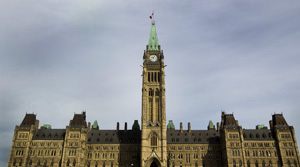
Although Canada’s economy has outperformed those of most other industrialized countries during the past several years, the federal government must take further steps to ensure that Canada’s finances are sustainable over the long run, said federal Finance Minister Jim Flaherty in his 2012 budget speech Thursday.
“Canadians need to be confident in our prospects for economic growth,” Flaherty said. “This is key to not only creating good jobs but also to sustaining our social programs and improving our quality of life.”
The federal government maintains that its budget program of modest cuts and specific spending increases puts the country on track to eliminate the federal deficit — forecast to reach about $24.9 billion in fiscal 2011-12 — by fiscal 2015-16. The all-important debt/gross domestic product ratio is forecast to fall to 28.5% by fiscal 2016-17 from close to 35% predicted for fiscal 2011-12.
“We can eliminate the deficit through common sense, moderate restraint. We have no need to resort to the drastic cuts being forced on some other developed countries today,” said Flaherty. “We have no need to undertake the radical austerity measure imposed by the federal government in the 1990s.”
Flaherty characterized the cuts as “modest,” amounting to less than 2% of federal program spending overall.
The budget proposes a couple of big moves to contain expenses that were telegraphed to Canadians well before the budget was officially introduced. As widely rumoured, for example, the federal government proposes to increase gradually the age of eligibility for Old Age Security and the Guaranteed Income Supplement to 67 from 65 beginning in 2023. The change would be fully implemented by 2029. Also, individuals would have the opportunity to defer receiving their OAS benefits to a later date.
“This gradual approach will enable younger Canadians to plan ahead with confidence,” Flaherty said. At the same time, it opens up new financial planning challenges for many financial advisors and their clients.
Another topic that was much discussed in recent weeks was the federal government’s plans to reduce departmental spending. In the budget, Ottawa says the spending reductions will amount to roughly $5.2 billion. These reductions are the result of an assessment of about $75 billion in direct program spending by departments and agencies. “Major transfers to persons and transfers to other levels of government were excluded from the review,” according to budget documents.
The spending reductions would result in the elimination of 19,200 federal jobs — or 4.8% of the federal workforce — over three years. The cost of these workforce cuts is pegged at $900 million.
The budget offers several targeted spending programs, such as $400 million to help increase private sector investment in early-stage risk capital and $105 million over two years to support forestry innovation and market development.
There is also a grab-bag of proposals to support research, education and training, including $500 million over five years starting in 2014-15 for the Canadian Foundation for Innovation to support advanced research infrastructure.
Flaherty acknowledged that the global economy remains fragile and that Canadians are concerned about whether they will have enough money for retirement and whether their social programs will be around for their children.
In a swipe against some opposition politicians who would follow other policies to address these concerns, Flaherty noted: “There are some who would raise taxes, increase government spending and shun new trading opportunities. These short-sighted, irresponsible and dangerous policies would kill jobs, impose crushing deficits and cripple our economy. They would squander Canada’s advantages.”
Flaherty countered: “We will not raise taxes. We will maintain our consistent, pragmatic and responsible approach to the economy.”